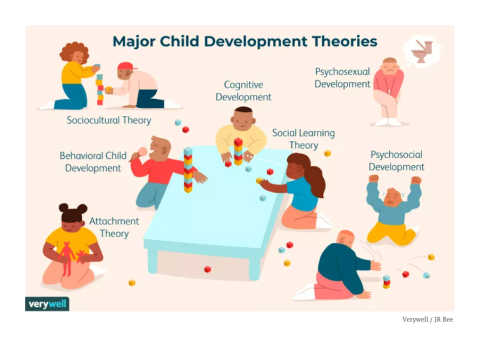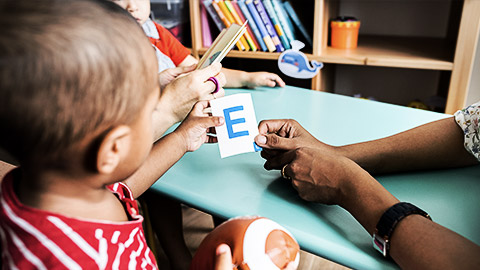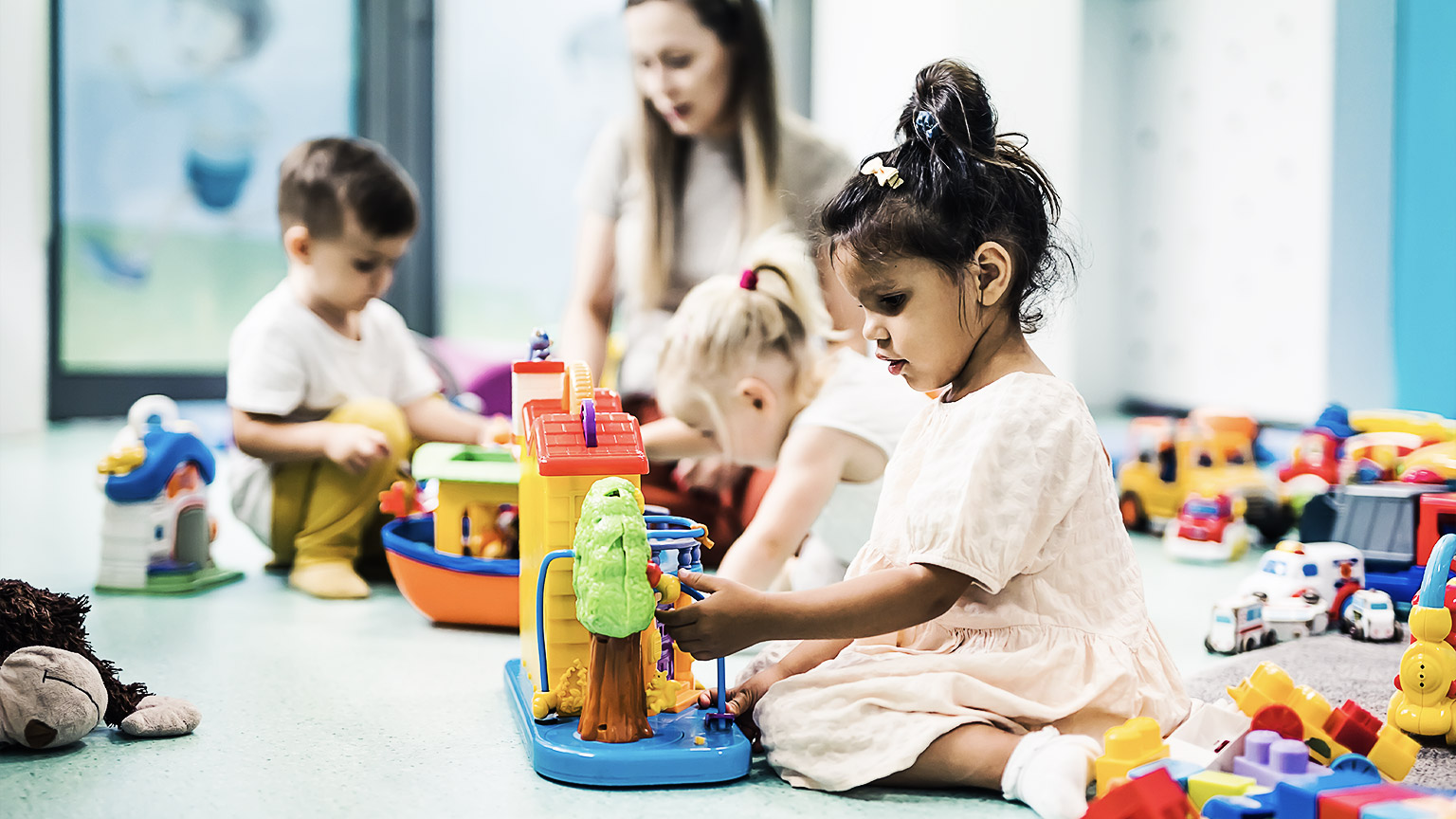Theories of development provide a framework for thinking about human growth and learning.
Child development that occurs from birth to adulthood was largely ignored throughout much of human history.
Children were often viewed as simply small versions of adults, and little attention was paid to the many advances in cognitive abilities, language usage, and physical growth that occur during childhood and adolescence.

Major Childhood Development Theories include:
- Cognitive Development Theory – Jerome Bruner
- Cognitive Theory – Jean Piaget
- Attachment Theory – John Bowlby and Mary Ainsworth
- Psychosocial Developmental Theory – Erik Erikson
- Social Learning Theory – Albert Bandura
- Psychosexual Developmental Theory – Sigmund Freud
- Ecological System Theory – Urie Bronfenbrenner
The following subtopics will provide information about each theory.
Jerome BrunerThe young child approaching a new subject or a new problem is like the scientist operating at the edge of his chosen field.
Cognitive psychologist Jerome Bruner felt the goal of education should be intellectual development, as opposed to rote memorization of facts.
Regarding learning and education, Bruner believed :
- curriculum should foster the development of problem-solving skills through the processes of inquiry and discovery
- subject matter should be represented in terms of the child's way of viewing the world
- curriculum should be designed so that the mastery of skills leads to the mastery of still more powerful ones
- teaching is done by organising concepts and learning by discovery
- culture should shape ideas through which people organize their views of themselves and others and the world in which they live.
Jean PiagetWhen you teach a child something you take away forever his chance of discovering it for himself.
Piaget is best known for his theory of cognitive development in children. He proposed that children’s cognitive skills progress through a series of stages in which the child takes in new information and understanding from experiences. He was a notable psychologist and scientist of his time.
Piaget’s Cognitive Developmental Theory states that children, quite simply, think differently than adults. While this may seem obvious to some, this was a revolutionary theory that went on to provide the foundations for several other theories to come. Essentially, this theory divided the child's life into four separate categories, or stages, each of which carries its own important qualities and vulnerabilities.
John BowlbyTry to prise a limpet away from its rock and it will cling all the harder.
Attachment theory is rooted in the joint work of John Bowlby and Mary Ainsworth, whose research first documented the importance of the relationship that develops between a mother and her child. Additionally, this research helped to document the negative impact on children’s development resulting from parental separation, deprivation, or bereavement.
In Bowlby’s Attachment Theory, he asserted that much of child development is based on the innate need of children to form attachments. These attachments may involve any number of people, places, or things, and ultimately have a substantial effect on development patterns throughout life.
Erik EriksonChildren love and want to be loved and they very much prefer the joy of accomplishment to the triumph of hateful failure. Do not mistake a child for his symptom.
Erik Erikson was an important figure in the fields of psychoanalytic and psychological development. He coined the phrase “identity crisis”. Central to much of his work was his theory on psychosocial development. As it became known, Erikson’s Psychosocial Developmental Theory produced a framework for organizing human growth, through all stages of life, into eight distinct stages. The principles of social interaction and experience are key to the outcomes of the child stages and beyond.
Social Learning Theory, Albert Bandura 1977Most human behavior is learned observationally through modeling: from observing others one forms an idea of how new behaviors are performed, and on later occasions, this coded information serves as a guide for action.
Albert Bandura’s Social Learning Theory is commonly relied on today across many industries and professions. This theory states that while much of child learning and development does come from direct experience, much also comes from modelling and simple observations. Bandura is considered a pioneer and an important figure in psychology.
Bandura's child development theory suggests that observation plays a critical role in learning, but this observation does not necessarily need to take the form of watching a live model. Instead, people can also learn by listening to verbal instructions about how to perform a behaviour as well as through observing either real or fictional characters displaying behaviours in books or films.
Sigmund FreudThere is little that gives children greater pleasure than when a grown-up lets himself down to their level, renounces his oppressive superiority and plays with them as an equal.
Freud’s Psychosexual Developmental Theory was one of these important products in which Freud explained that child experiences, experienced at different ages in childhood, directly go on to dictate personality and behaviour patterns in adults. This general theory has since produced countless studies, disciplines, and other academic and business establishments.
Lev S. VygotskyThe teacher must adopt the role of facilitator not content provider.
Another psychologist named Lev Vygotsky proposed a groundbreaking learning theory that has gone on to become very influential, especially in the field of education. Like Piaget, Vygotsky believed that children learn actively through hands-on experiences.
His theory also suggested that parents, caregivers, peers, and the culture at large were responsible for developing higher-order functions — the mental processes of analysis, understanding, and evaluation. In Vygotsky's view, learning is a social process. Through interacting with others, learning becomes part of an individual's understanding of the world.
This child development theory also introduced the concept of the zone of proximal development, which is the gap between what a person can do with help and what they can do on their own. With the help of more knowledgeable others, people can learn and increase their skills and scope of understanding through life.
Urie BronfenbrennerIn order to develop normally, a child requires...activity with one or more adults who have an irrational emotional relationship with the child. Somebody's got to be crazy about that kid. That's number one. First, last, and always.
Urie Bronfenbrenner developed the ecological systems theory to explain how everything in a child and the child’s environment affects how a child grows and develops. The theory also states that how a child acts or reacts to the people in their microsystems will affect how they treat her in return. The following terms will help you to understand this theory.
- Microsystem – children’s immediate contact, families, pre-school. A lot of influences take place in the child's main primary area.
- Mesosystem – those who are connected between parents and teachers. For example, when parents and teachers talk about the child's sleeping habits and what the child has been doing for the day.
- Exosystem – wider social system in which the children grow up. For example, their parents' commitment to their jobs and financial status will directly or indirectly impact the children.
- Macrosystem – refers to the children’s cultural context. For example, the economy, changes in government, culture, values in the community and society, and the legal structure of living.
- Chronosystem – This theory looks at the influences that impact children’s learning development, in society, relationships, governments, education, and finance.

In preparation for one of your assessments, which requires you to work in groups, you will be able to get together (online) with your assessment group and do this activity. Consider it a warm-up for the assessment. Your tutor will communicate who is in your group.
Here is a sneak peek at what you will be asked to do in the assessment at the end of this module:
- Each group member is required to prepare their own slides (maximum of 4) and speak for approximately two minutes on their theory and its relevance to ECE in Aotearoa.
- As this is a group presentation, all slides must follow the same format and design, and flow together to create one presentation.
- All sources of information should be referenced using APA 7th style referencing
THIS TASK:
- Use an online video-chat tool like Zoom or MS Teams to get together with the group you will be doing your final assessment with.
- Split the group into two smaller groups.
- One group will research and summarise Cognitive Development Theory – Jerome Bruner, and the other group will research and summarise Jean Piaget's Cognitive Theory
- Start with the information we've provided, then further research your theory to develop an overall picture and summary
- In your summary, explain why your group thinks this theory is important in Early Childhood Education.
- Work in your smaller groups to create a slide presentation
- Have another online meeting where each group presents the information to each other. Take a screenshot or photo of each group presenting their slides so that you can upload them to a journal post.
- After the presentations, have a conversation comparing the two theories. Although both theories are valid and important, you may choose to debate which you think has more relevance in ECE in Aotearoa today
- Upload your screenshots to a journal post and publish them for the class to view.

